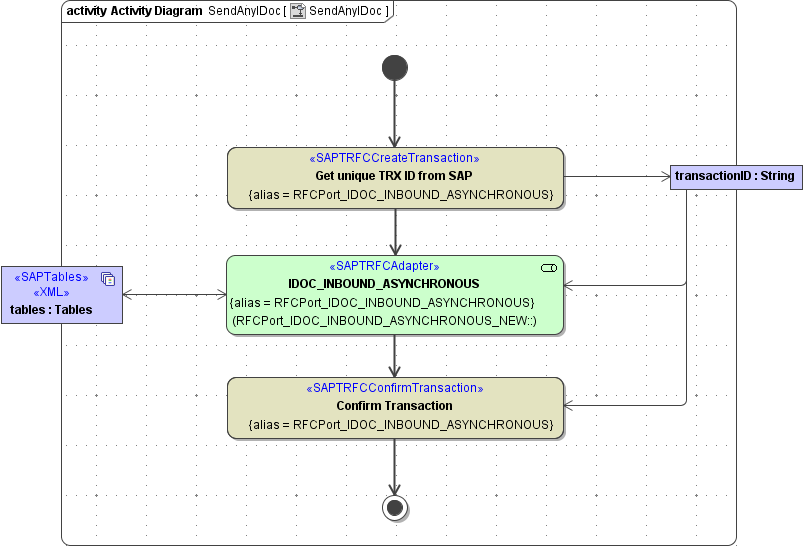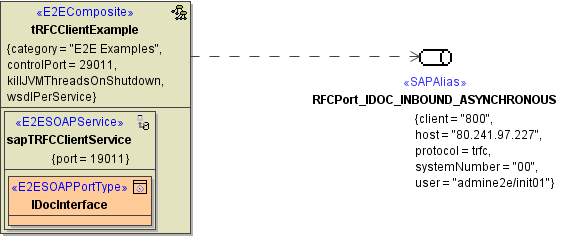Page History
Versions Compared
Key
- This line was added.
- This line was removed.
- Formatting was changed.
| Div | ||||||||||
|---|---|---|---|---|---|---|---|---|---|---|
| ||||||||||
|
Modeling tRFC clients is explained by an example showing how the Bridge can send IDocs to SAP. This is the most common use case for tRFC clients. The difference between tRFC and RFC is the additional transaction handling. This transaction handling must guarantee that one transaction can be executed only once.
| Multiexcerpt include | ||||||
|---|---|---|---|---|---|---|
|
In the simple example in the current UML model we show only how to use the transaction mechanism offered by SAP. The proper transaction control is implemented elsewhere (cf. the SAP module). The next section gives an overview of the components required to build a tRFC client.
Calling tRFC Functions
Accessing SAP via tRFC requires the following adapters:
| Adapter | Description |
|---|---|
| <<SAPTRFCCreateTransaction>> | This adapter tries to get a transaction ID from the SAP system.
|
| <<SAPTRFCAdapter>> | The tRFC Adapter takes all input data and the current transaction ID and sends them to the SAP system using the tRFC protocol. Possible input parameters are import and tables. Output parameters are not support because the tRFC protocol is asynchronous. In all other respects, the <<SAPTRFCAdapter>> works like the <<SAPRFCAdapter>>.
|
| <<SAPTRFCConfirmTransaction>> | This adapter confirms the successful termination of a transaction. It must be called only if no errors occurred during execution of the <<SAPTRFCAdapter>>. |
| Note | ||
|---|---|---|
| ||
| In contrast to tRFC between SAP systems, a transaction from an RFC client must contain only one RFC function. |
The activity diagrams that access the SAP system in the example file (SendAnyIDoc and SendTXTRAW) are the implementations of the SOAP Port Type IDocInterface. Both activity diagrams call IDOC_INBOUND_ASYNCHRONOUS to send an IDoc to the SAP system (see for example figure below). The only difference is, that SendTXTRaw requires a TXTRAW IDoc as input whereas SendAnyIDoc the same input parameters.
Figure: Activity Diagram Example Of Calling tRFC Functions
 Image Modified
Image Modified
| Info | ||
|---|---|---|
| ||
If you drag and drop the operation from the containment tree to the diagram pane, it will get the stereotype <<SAPRFCAdapter>>. To replace this with the desired stereotype <<SAPTRFCAdapter>> you have to remove the old stereotype first and then select the new one from the list, because <<SAPTRFCAdapter>> will not show up on the list of available stereotypes as long as <<SAPRFCAdapter>> is still selected. |
tRFC Client Components
The components depicted in the figure below send IDocs from the frontend via tRFC to SAP. The frontend interface is SOAP. Therefore, the configuration holds a SOAP service component, namely saptRFCClientService. This component contains a SOAP IDocInterface whose operations do the actual calling of the SAP tRFC interface.
Figure: tRFC Client Component Diagram
 Image Modified
Image Modified
The component tRFCClientExample contains a SOAP service accessing the SAP system. This SAP system is modeled as an SAP Alias (RFCPort_IDOC_INBOUND_ASYNCHRONOUS) used by the tRFC adapter.
The <<SAPAlias>> holds the following tagged values:
| Multiexcerpt include | ||||
|---|---|---|---|---|
|
| Info | ||
|---|---|---|
| ||
systemNumber and routerString can be found in the SAP GUI logon panel. |
| Info | ||||||||
|---|---|---|---|---|---|---|---|---|
| ||||||||
|
Client Connection Options
Via the SAP alias and the configuration descriptor we get the protocol and the connection string. This string looks like:
name1="value1" name2="value2" ...
| Note | ||
|---|---|---|
| ||
The connection string must be provided in the following format: <optionName>="<optionValue>"<space><optionName>="<optionValue>"... Failure to conform with the pattern will lead unrecognized options. Those errors won't be reported, but affect SAP behavior (e.g. you'll get a SAP connection error with |
Following options are available :
| Name | Description | Values | Default | ||||||
|---|---|---|---|---|---|---|---|---|---|
| ABAP_DEBUG | RFC with ABAP debugger | 0 | without Debugger | 0 | |||||
| 1 | with Debugger | ||||||||
| ASHOST | Host name of a specific application server (R/3, No Load Balancing) | ||||||||
| CFIT | Conversion Fault Indicator Token. This flag determines substitute symbol for received Unicode characters, which could not be converted by the RFC library. | non Unicode systems 0x23, Unicode systems 0xfffd, or defined by environment variable RFC_REPL_CHAR | |||||||
| CODEPAGE | The given codepage is to be used for this connection (Default is either 1100 or set by RfcSetSystemCodepage or is set by SAP_CODEPAGE environment variable). Could be rather useful if the sapgui should be started with codepage differs from 1100. | ||||||||
| COMM_CP | When communication has to be established between an Unicode Library and a Non Unicode system, all char like data will be converted into codepage which matched to logon language before send them. This codepage is called communication codepage. The effect of this method is that the Non Unicode System is sure to talk an system with communication codepage and not with an Unicode system. Usually the RFC Library determines automatically the communication codepage. Using this option it is possible for the programmer to set the communication codepage directly. This option is only active in the Unicode version of the RFC library. | ||||||||
| DEST | Destination in saprfc.ini if working with saprfc.ini. If the RFC server is an R/2 system this destination must also be defined in the 'sideinfo' for the SAP gateway. | ||||||||
| GROUP | Name of the group of application servers (if using Load Balancing) | ||||||||
| GRT_DATA | SAProuter connect data for SAPGUI when using RFC with SAPGUI. /H/...... : the whole router string for SAPGUI. /P/password: If the password for the SAPGUI connection is not the same as the one for the RFC connection. | ||||||||
| GWHOST | Host name of the SAP gateway (if server is R/2 or External) | ||||||||
| GWSERV | Service of the SAP gateway (if server is R/2 or External) | ||||||||
| ICCE | Ignore Character Conversion Errors. This flag determines the runtime behavior of the RFC library concerning character conversion. If this flag is 1, the concerned API will not exit with error, but replace the character which could not be converted with CFIT defined token. | 0 | not ignore | 0 or defined by environment variable RFC_IGNORE_CONV_ERROR | |||||
| 1 | ignore | ||||||||
| IDLE_TIMEOUT | Inform the Web Application Server to close the connection after idle time in seconds. | ||||||||
| LCHECK | Logon check at OPEN time | 0 | without check | 1 | |||||
| 1 | with check | ||||||||
| MSHOST | Host name of the Message Server (if using Load Balancing) | ||||||||
| MSSERV | Service of the Message Server (if using Load Balancing) | ||||||||
| NEWPASS | Changes the password during logon
| ||||||||
| PCS | Partner's Char Size. The RFC-library determines automatically the partner's char size at open time (using logon check) or at first call time (without logon check).
| 1 | Non Unicode | 1 | |||||
| 2 | Unicode | ||||||||
| R3NAME | Name of the SAP system (if using Load Balancing) | ||||||||
| SAPLOGON_ID | String defined for SAPLOGON on 32-bit Windows | ||||||||
| SNC_LIB | Path and name of the SNC-library | ||||||||
| SNC_MODE | Working with SNC | 0 | without SNC | 0 (see RFC_SNC_MODE) | |||||
| 1 | with SNC | ||||||||
| SNC_MYNAME | Own SNC name if you don't want to use the default SNC name | ||||||||
| SNC_PARTNERNAME | SNC name of the SNC partner (RFC server) or SNC name of the message server (Load Balancing) | ||||||||
| SNC_QOP | SNC Quality of service | 8 (RFC_SNC_QOP_DEFAULT, see RFC_SNC_QOP) | |||||||
| SYSNR | SAP system number (R/3, No Load Balancing) | ||||||||
| TOUPPER | conversion of user and password to upper case for sending to Web Application Server | 0 | do not convert password to upper | 1, i.e. convert to upper case | |||||
| 1 | convert password to upper | ||||||||
| TPHOST | Host name of the external RFC server program | ||||||||
| TPNAME | Path and name of the external RFC server program or Program ID of an registered RFC server program. | ||||||||
| TRACE | RFC trace | 0 | without trace | 0 | |||||
| 1 | with trace | ||||||||
| TYPE | RFC server type, 2/3/E: R/2 or R/3 or External System | 3 | |||||||
| USE_SAPGUI | RFC with SAPGUI. If the sapgui is to be started with codepage differs from 1100, please use option CODEPAGE to define the codepage you need. | 0 | without SAPGUI | 0 | |||||
| 1 | with SAPGUI | ||||||||
| 2 | invisible SAPGUI | ||||||||
| WAN_CONN | RFC via Wide Area Network.
| 0 | LAN | 0 | |||||
| 1 | WLAN | ||||||||
Alternative login possibilities:
| Name | Description |
|---|---|
| ALIAS_USER | An alias user name, could used instead of user or even together with USER. If both USER and ALIAS_USER are used, than they have to be match. |
| EXTIDDATA | Contains valid external user's ID of an external authentification system. User name is optional. External ID is to be defined in the backend (SAP-System). |
| EXTIDTYPE | Defines the kind of external identity. Valid only with EXTIDDATA. Follow values are not allowed: ID, NT; DN, CA, X, HX. Additionally, RFC Library provides the feature to retrieve MYSAPSSO2 certificate from the backend after successful logon. |
| GETSSO2 | Request to create a cookie version 2 using given password and user name. If the value is 1, the cookie will be generated from user and password values given by USER=user and PASSWORD=password in the same connect_param string. Instead, user and password X.509 certificate could be used. If the RfcOpenEx call ended successfully, the generated SAP cookie version 2 can be retrieved via RfcGetTicket API. |
| MYSAPSSO | SAP Cookie Version 1. Will be used instead of user and password for logon to backend |
| MYSAPSSO2 | SAP Cookie Version 2. Will be used instead of password for logon to backend. In this case, user name is optional. |
| X509CERT | An X.509 certificate will be used instead of password to logon to SAP System. In this case, user name is optional. |
| Panel | ||
|---|---|---|
| ||
|
| Panel | ||
|---|---|---|
| ||
| Panel | ||
|---|---|---|
| ||